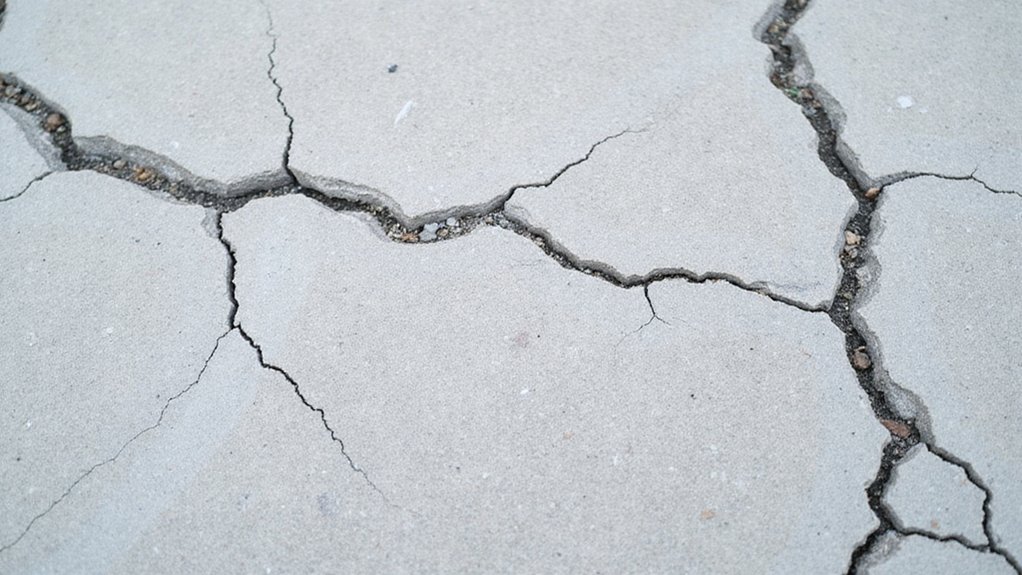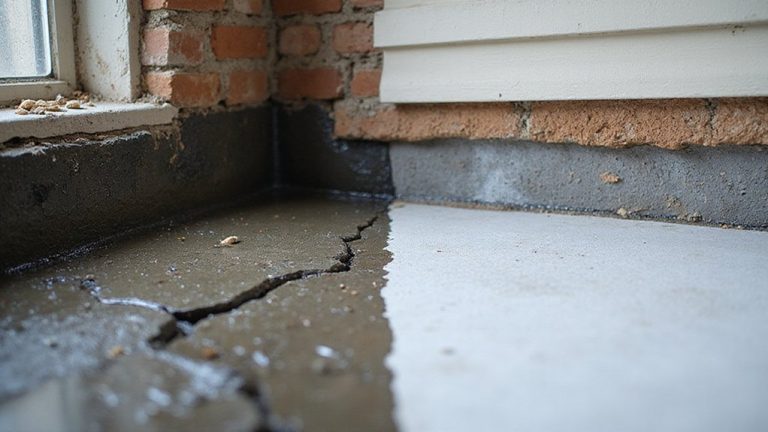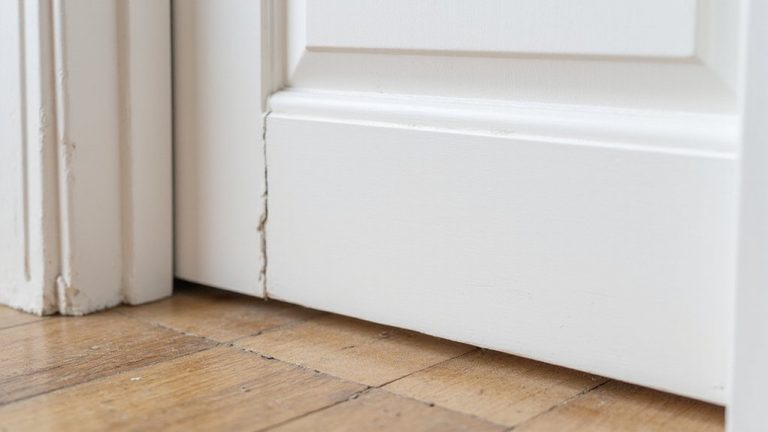As winter's temperature swings wreak havoc on your home's foundation, you'll want to understand how freeze-thaw cycles can silently compromise your biggest investment. Water seeps into tiny cracks, then expands as it freezes, turning microscopic imperfections into potential structural threats. Your foundation's integrity hangs in the balance, with each temperature fluctuation potentially widening the risk of serious damage. Curious about what's really happening beneath your feet?
How Freeze-Thaw Cycles Work
When water seeps into small cracks in your foundation, it can create a damaging cycle that threatens your home's structural integrity. As temperatures drop, this water freezes and expands, widening existing cracks. Expansive soils around foundations can exacerbate this process by increasing ground movement and stress. The soil composition around your foundation plays an indispensable role in this process, with high ground saturation increasing the risk of damage. When temperatures rise, the ice melts, creating additional stress on your foundation's walls. This repeated freeze-thaw cycle can gradually weaken your home's foundation, potentially leading to significant structural issues that'll require costly repairs.
Common Signs of Foundation Water Damage
Repeatedly experiencing freeze-thaw cycles can leave telltale marks on your home's foundation, indicating potential water damage. You might notice cracked foundation walls, which can signal serious structural issues that need immediate attention. Foundation repair contractors can help diagnose and address these critical structural concerns in both residential and commercial buildings.
Uneven concrete floors are another red flag, suggesting water has compromised your foundation's stability. Hairline fractures, moisture stains, and subtle floor slope changes can hint at underlying problems. If you're seeing these signs, don't panic—professional assessment can help diagnose and address potential damage before it worsens.
Catching these symptoms early can save you significant repair costs and protect your home's structural integrity.
Vulnerable Foundation Materials and Structures
Because foundations are complex structural systems, some materials are more susceptible to damage from freeze-thaw cycles than others. Concrete aggregates, for instance, can crack and deteriorate when water penetrates their surface and repeatedly freezes and expands.
Clay soils are particularly vulnerable, with soil expansion causing significant stress on foundation walls and footings. If you've got a concrete or masonry foundation, you'll want to pay close attention to potential weak points. Proper insulation, drainage, and regular inspections can help mitigate the risks of freeze-thaw damage and protect your home's structural integrity.
Regions Most at Risk for Foundation Deterioration
Although foundation damage can occur in many climates, some geographic regions face dramatically higher risks of freeze-thaw deterioration. If you live in the Northeastern, Midwestern, or Northwestern United States, your home's foundation is especially vulnerable to soil expansion and frost heave.
These areas experience frequent temperature fluctuations that cause ground moisture to repeatedly freeze and thaw, creating immense pressure on your foundation. Concrete and masonry structures are particularly susceptible to cracking and structural weakening during these cycles.
Understanding your region's climate patterns can help you proactively protect your home's structural integrity.
Preventative Maintenance Strategies
Since your foundation faces significant risks in regions with frequent freeze-thaw cycles, implementing proactive maintenance strategies can help protect your home's structural integrity. Regular seasonal inspections are vital for detecting early signs of damage.
You'll want to establish extensive maintenance schedules that include checking for cracks, monitoring drainage, and ensuring proper terrain grading around your foundation. By sealing potential entry points and maintaining consistent moisture levels, you can minimize the risk of water infiltration and subsequent freeze-thaw damage.
Your diligence now can prevent expensive repairs later and preserve your home's stability.
Professional Inspection and Assessment Techniques
How can you truly safeguard your foundation against freeze-thaw damage? Professional foundation inspectors use specialized techniques to assess potential risks. They'll perform thorough visual inspections, examining your foundation's surface for hairline cracks, uneven settling, and water penetration signs.
Moisture monitoring equipment helps detect hidden moisture problems that could compromise your home's structural integrity. Trained professionals use thermal imaging cameras and advanced sensors to identify temperature variations and potential weakness zones.
Repair Options for Freeze-Thaw Damage
Professional foundation inspections reveal diverse repair strategies to combat freeze-thaw damage effectively. When addressing foundation repair costs, you'll want to evaluate options that stabilize your home's structural integrity.
Experts might recommend hydraulic pier installation, which lifts and levels your foundation, preventing further damage. Polyurethane foam injections can also seal cracks and provide immediate stabilization. Waterproofing membranes and drainage improvements can help mitigate future freeze-thaw cycles.
While repair expenses might seem formidable, investing in professional solutions now can save you significant money and stress in the long run.
Long-Term Protection for Your Foundation
Because foundation damage can escalate quickly, protecting your home from freeze-thaw cycles requires a proactive, strategic approach. You'll want to invest in thorough waterproofing techniques that create a robust barrier against moisture infiltration.
Foundation reinforcement methods, like installing drainage systems and applying specialized sealants, can substantially minimize potential structural risks. By addressing potential vulnerabilities early, you'll safeguard your home's structural integrity and prevent costly repairs.
Professional assessments and targeted interventions can help you maintain a solid foundation that withstands challenging climate conditions, ensuring your home remains stable and secure for years to come.
Frequently Asked Questions
How Quickly Can Freeze-Thaw Damage Impact My Home's Foundation?
You'll see foundation damage develop rapidly when soil moisture levels fluctuate and frost heave intensity increases, potentially causing significant structural shifts within one to three winter seasons.
Are Older Homes More Susceptible to Freeze-Thaw Foundation Issues?
You'll find older homes are more vulnerable due to their soil composition and less advanced foundation materials. Seasonal shifts can accelerate damage in structures with aging foundations, potentially causing more significant structural stress.
Can Homeowners Insurance Cover Foundation Damage From Freeze-Thaw Cycles?
Your insurance coverage depends on policy limitations and specific claims process requirements. You'll need to carefully review your policy to understand if freeze-thaw foundation damage qualifies for compensation.
Do Underground Water Pipes Contribute to Foundation Freeze-Thaw Problems?
Your underground water lines can suffer damage from seasonal fluctuations, potentially compromising your foundation's stability. These pipes expand and contract, creating stress that might lead to structural issues around your home.
What's the Average Cost of Repairing Freeze-Thaw Foundation Damage?
You'll face repair costs ranging from $2,000 to $10,000, depending on seasonal temperature fluctuations and damage extent. Average repair estimates suggest investing early prevents more expensive structural problems.



